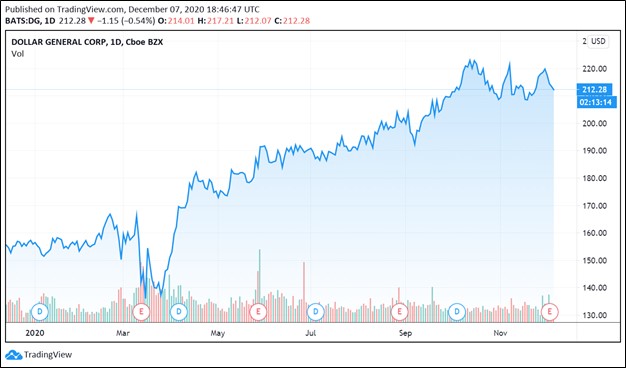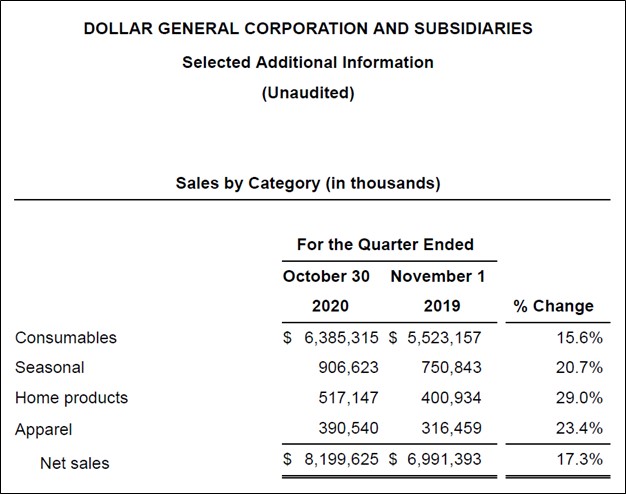Member LoginDividend CushionValue Trap |
Dollar General Continues to Impress
publication date: Dec 7, 2020
|
author/source: Callum Turcan
Image Shown: Shares of Dollar General Corporation have surged higher over the past year. By Callum Turcan On December 3, Dollar General Corporation (DG) reported third quarter earnings for fiscal 2020 (period ended October 30, 2020) that saw its same-store sales grow by over 12% year-over-year, which when combined with its steadily growing store count, saw the firm’s GAAP revenues jump higher by over 17% year-over-year. Dollar General has made great strides in upgrading its digital operations, expanding its store base, adding new products to its stores, and improving its cost structure during the past several fiscal years. These past initiatives are filtering down to Dollar General’s bottom line as its diluted GAAP EPS was up 63% year-over-year in the fiscal third quarter. We continue to be big fans of Dollar General and include shares of DG in our Best Ideas Newsletter portfolio. Quarterly Update Management noted that sales were strong across the board last fiscal quarter including at the firm’s “consumables, seasonal, home products and apparel categories” and that “the largest percentage increase [was] in the home products category.” Additionally, Dollar General reported that the coronavirus (‘COVID-19’) pandemic played a role in boosting US household demand for certain products, as has been the case at many retailers that sell significant amounts of consumer staples products. Here is what management had to say during Dollar General’s latest earnings call (emphasis added): “Once again this quarter, we increased our market share in highly consumable product sales as measured by syndicated data, driven by double-digit increases in both units and dollars. Importantly, our data suggested increase in new customers this quarter as compared to Q3 of 2019. These new customers skew younger, higher income and more ethnically diverse, further underscoring the broadened appeal of our value and convenience proposition.” --- Todd Vasos, CEO of Dollar General We appreciate Dollar General’s widespread sales strength and apparent ability to win over new customers, and in our view, some of these recent gains have legs. Recent market share gains underpin our favorable view towards Dollar General. In the upcoming graphic down below, Dollar General highlights its sales performance by category last fiscal quarter. Though non-consumables sales have grown significantly of late, please note that consumable product sales remain the backbone of Dollar General’s operations.
Image Shown: Dollar General reported strong sales growth across the board last fiscal quarter. Image Source: Dollar General – Third Quarter of Fiscal 2020 Earnings Press Release Dollar General’s GAAP gross margins rose by almost 180 basis points last fiscal quarter, hitting ~31.3%, due in part to rising non-consumables product sales as a percentage of company-wide revenues (these products, generally speaking, have higher gross margins than its consumable product sales). The retailer also noted that its initial markups on inventory purchases were higher, that it experienced a reduction in markdowns as a percentage of net sales, and that its inventory-shrink as a percentage of net sales shifted lower last fiscal quarter. Higher distribution and transportation expenses were more than offset by the favorable aforementioned tailwinds. Pivoting to Dollar General’s GAAP operating margin, that rose by approximately 240 basis points year-over-year last fiscal quarter, hitting ~9.4%. Economies of scale helped drive down its SG&A expenses as a percent of net sales last fiscal quarter versus year-ago levels, which when combined with its gross margin improvements, resulted in material operating margin expansion. Dollar General did not provide full-year guidance for fiscal 2020 in terms of expected revenue or EPS performance, though management did note that the firm’s same-store sales growth rate held up from the October 30 to December 1 period, growing roughly 14% year-over-year. That speaks very favorably to Dollar General’s growth trajectory going forward. Financial Update During the first nine months of fiscal 2020, Dollar General generated $3.4 billion in net operating cash flow and spent $0.7 billion on its capital expenditures, allowing for $2.7 billion in free cash flow (up sharply from the $1.6 billion in free cash flow generated in the same period last fiscal year). The firm spent $1.6 billion buying back its stock and $0.3 billion covering its dividend obligations during the first nine months of fiscal 2020. Dollar General intends to spend around $1.0-$1.1 billion covering its capital expenditures and about $2.5 billion buying back its stock in fiscal 2020. As of October 30, Dollar General had a $1.9 billion net debt position (inclusive of short-term debt), though please be aware its operating lease liabilities are also very material ($9.3 billion in both short- and long-term operating lease liabilities combined). The firm did not have a significant amount or any short-term debt on the books as of October 30. We view Dollar General’s net debt position as manageable given its ability to generate sizable free cash flows and due to its ample liquidity on hand ($2.2 billion in cash and cash equivalents on the books as of October 30). Though we would prefer the company to have a net cash position, its net debt load has been trending the right way recently and was down roughly $0.3 billion (inclusive of short-term debt) from levels seen as of November 1, 2019. Dollar General has solid investment grade credit ratings (Baa2/BBB) which supports its ability to tap capital markets for funds at attractive rates. The firm has a $1.25 billion revolving credit line that matures in September 2024 for its near- and medium-term liquidity needs. As of October 30, Dollar General did not have any outstanding borrowings against that facility (though it did have a negligible amount of letters of credit posted against the facility). Here is what management had to say regarding Dollar General’s capital allocation priorities during the firm’s latest earnings call (emphasis added): “Our capital allocation priorities continue to serve us well and remain unchanged. Our first priority is investing in high return growth opportunities including new store expansion and our strategic initiatives. We also remain committed to returning significant cash to shareholders through anticipated share repurchases and quarterly dividend payments, all while maintaining our current investment-grade credit rating and managing to leverage ratio of approximately 3x adjusted debt to EBITDA.” --- John Garratt, CFO of Dollar General Looking ahead, Dollar General intends to pursue 2,900 real estate projects in fiscal 2021 (1,050 new store openings, 1,750 remodels, and 100 store relocations), up from 2,780 real estate projects that the firm is targeting in fiscal 2020 (1,000 new store openings, 1,670 remodels, and 110 store relocations). Some of its capital expenditures will goes toward its new store concept, pOpshelf, that was announced in October 2020. The retailer aims to open 30 pOpshelf store locations by the end of fiscal 2021, and Dollar General has already opened at least a couple of these new store concepts according to recent management commentary. We are intrigued by the new store concept and are keeping a close eye on the initiative, which primarily aims to grow Dollar General’s non-consumable sales. Concluding Thoughts Dollar General continues to fire on all cylinders and that is largely why, in our view, shares of DG are up 36% year-to-date as of this writing while the S&P 500 (SPY) is up 15% during this period (we are not taking dividend considerations into account here, though that would not change this picture much). The high end of our fair value estimate range for Dollar General sits at $223 per share, though please note that, for strong enterprises such as DG, we like to let our “winners” run. It is not until a firm’s technicals turn against it that we would consider removing a high quality name from the newsletter portfolios. Additionally, Dollar General’s dividend growth trajectory is quite promising, albeit from a low base. Shares of DG yield ~0.7% as of this writing, and we expect management will push through sizable increases going forward. Past digital investments, expanding its product offerings, and pursuing cost saving initiatives have been key to supporting Dollar General’s growth trajectory. We covered some of Dollar General’s major initiatives (including its nascent pOpshelf initiative) in this article here that we encourage interested members to check out. Dollar General continues to impress, and we continue to be big fans of the name. Dollar General’s Stock Landing Page >> ----- Also tickerized for DLTR, FIVE, BIG, OLLI, PRTY, RAD, GO, TJX, ROST ----- Valuentum members have access to our 16-page stock reports, Valuentum Buying Index ratings, Dividend Cushion ratios, fair value estimates and ranges, dividend reports and more. Not a member? Subscribe today. The first 14 days are free. Callum Turcan does not own shares in any of the securities mentioned above. Johnson & Johnson (JNJ) and Health Care Select Sector SPDR Fund (XLV) are both included in Valuentum’s simulated Best Ideas Newsletter portfolio and Dividend Growth Newsletter portfolio. Dollar General Corporation (DG) and The Walt Disney Company (DIS) are both included in Valuentum’s simulated Best Ideas Newsletter portfolio. Philip Morris International Inc (PM) and Vanguard Consumer Staples ETF (VDC) are both included in Valuentum’s simulated High Yield Dividend Newsletter portfolio. Some of the other companies written about in this article may be included in Valuentum's simulated newsletter portfolios. Contact Valuentum for more information about its editorial policies. |




0 Comments Posted Leave a comment